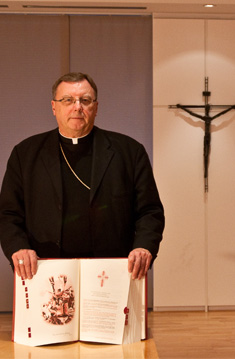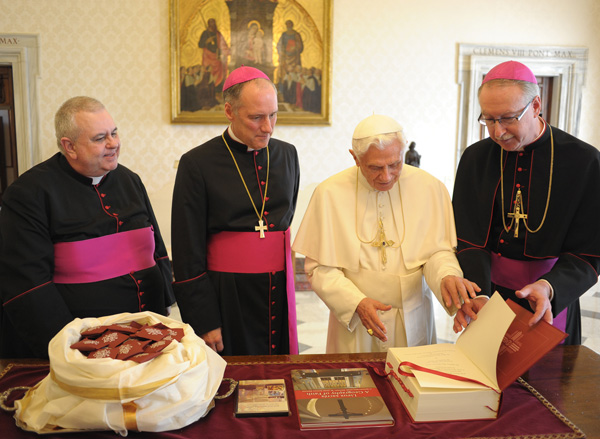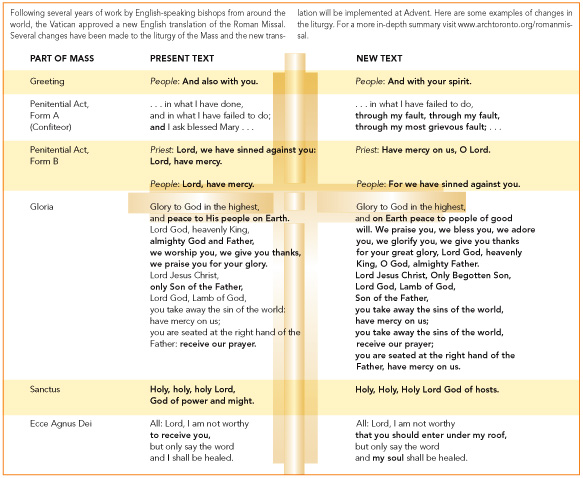“The hope is that the higher register of the vocabulary and the restoration of biblical allusions will enrich our life of prayer, heightening reverence and making the liturgy more solemn, more beautiful,” Prendergast told The Catholic Register.
Prendergast was the Canadian representative on the Vox Clara Committee, formed to oversee the new English translation of the Roman Missal.
In 2000, Blessed John Paul II announced the third edition of the Roman Missal. While the order of the Mass will stay the same, many things have happened since the last edition was implemented including additional eucharistic prayers and the canonization of many saints, meaning their feast days were added to the liturgical calendar. And in 2001, the Holy See changed the manner in which liturgical texts are to be translated to ensure accuracy and faithfulness to their Latin origins in a document called “On the Use of Vernacular Languages in the Publication of the Books of the Roman Liturgy” by the Congregation for Divine Worship and the Discipline of the Sacraments.
Some of the more noticeable changes for churchgoers include the much-used response “And also with you” being replaced by “And with your spirit.” The invitation to Communion now includes the words “Lord I am not worthy that you should enter under my roof,” while the Penitential Act includes “through my fault, through my fault, through my most grievous fault.”
But the prayer that has undergone the most change is the Gloria, said Prendergast. “When translators translated it in the 1970s, they not only abbreviated it but they rearranged the wording,” he said. What was lost in translation was the going overboard with praise of God, he said. “We praise you, we bless you, we adore you, we glorify you” has now been added.

Toronto Auxiliary Bishop John Boissonneau believes that developing an understanding the new language will bring people especially close to the liturgy.
- Michael Swan
The language itself won’t bring people closer to the liturgy, said Toronto Auxiliary Bishop John Boissonneau.
“It’s understanding why they say it which will bring people especially close to the liturgy,” said Boissonneau.
He said the new translation will make it a “little more clear” the scriptural roots of our prayers.
“We’ll be speaking the same language in our liturgy as we do in the reading of the Scriptures.”
It’s a chance for Catholics in all the English-speaking world to think about why we say these things, said Boissonneau.
But it’s not going to be a major shift for churchgoers.
“We’ll have the pew cards which are very important to follow along and to get used to some new responses and the way to sing the Gloria and the Creed and so forth.”
Fr. Gilles Mongeau, director of the master of divinity program at Toronto’s Regis College, offers an online course on the changes to the new Missal along with a day-long workshop. Mongeau said the more formal language will help people focus their attention on the sacred and let them hear all the scriptural elements in the prayers.
“If you don’t hear that, you don’t realize just how profoundly we are made to enter into the world of the Bible when you are at Mass,” said Mongeau.
And he said it is clear the clergy will be more affected by the changes, since they’ll be reading a lot of new words.
“This new Missal is an occasion for us to… put a little bit of effort again — both priests and people — into what Vatican II calls full and active participation in the liturgy.”
Christian McConnell, who teaches liturgy and the history of the liturgy at the University of St. Michael’s College, thinks the changes will be met with mixed reaction.
“But already, there are people who are reacting positively to it because the more formal nature of the language strikes them as more lofty and more appropriate for the sacredness of worship,” he said.
McConnell said parishioners can expect some clumsiness and awkwardness in the sound of the translations themselves for English speakers.
“Because good Latin style and good English style aren’t exactly the same,” he said.
“And that’s the trade-off if you adopt a formal equivalence approach. You’re prioritizing the accuracy of one word after another over the question of what good style would be in the receptor language.”
For more information on the Missal, see www.archtoronto.org/romanmissal.

Pope Benedict XVI talks with Archbishop Richard W. Smith of Edmonton, Alberta, right, during a meeting with officers of the Canadian bishops' conference at the Vatican Nov. 7. Also pictured are Msgr. Patrick Powers, secretary-general of the conference, l eft, and Archbishop Paul-Andre Durocher, recently named head of the Archdiocese of Gatineau, Quebec, and vice president of the conference. On the table is a specially bound copy of the Canadian edition of the new English translation of the Roman missal that the officers presented to the pope.
- CNS photo/L'Osservatore Romano
The Missal - Frequently Asked Questions
Q: What is the Roman Missal?
A: It is the book used by the priest at the altar during Mass that contains the prayers recited by him and the people during celebration of the Eucharist.
Q: Why is there a new Roman Missal?
A: Pope John Paul II promulgated a third edition of the Roman Missal (following editions in 1974 and 1984) in 2000. It recognizes many changes since Vatican II, such as additional eucharistic prayers, new saints and feast days, and most significant a more precise translation of the original Latin text that was used prior to Vatican II.
Q: What was wrong with previous editions of the Roman Missal?
A: Following Vatican II there was a sense of urgency to implement an English Mass as well as a cultural move to use vernacular language that would appeal to churchgoers and encourage their participation in the Mass. In retrospect, the translation was seen to be imperfect and a decision was made to try again but this time remain as faithful as possible to the original Latin.
Q: Why has it taken 11 years to implement?
A: There are 11 English-language episcopal conferences in the world. They had to reach agreement on the complex matter of translating the original Latin into an English text that would meet the Vatican standards for a literal translation. It was a meticulous process.
Q: Does this mean the Mass is changing?
A: No, the Mass is not changing from the Order of the Mass (Novus Ordo) promulgated after the Second Vatican Council. What will change are many words and phrases spoken by the priest and the congregation. Many vernacular words and phrases are being replaced by more formal translations.
Q: Can you give some examples?
A: For instance, when the priest says “The Lord be with you” the response will be “And with your spirit,” a literal translation of the Latin et cum spiritu tuo. The Penitential Act now includes the words “I have greatly sinned” and it adds the phrase “through my fault, through my fault, through my most grievous fault.”
Q: Why does the Church want the language of Mass to be more formal?
A: Following Vatican II the Church became more informal in an attempt to be more welcoming. There is concern, however, about a decline in reverence. The Church is seeking to address that imbalance.
Q: Who will be most affected by changes?
A: Parishioners will be much less affected by the changes than priests, who will notice revisions to most Mass prayers they say silently and aloud.
Q: Can my priest continue to use the old version of the missal?
A: Use of the new Roman Missal is mandatory and it must be implemented in Canadian churches at the first Sunday of Advent.
Q: Besides the new translation, are there other changes to the Mass?
A: Some of the new translations require changes in the music played at Mass, for instance to the Gloria and Holy, Holy.
Q: How will I be able to learn the new prayers?
A: Many parishes will distribute pamphlets with the revised prayers. Other resources are a Canadian Conference of Catholic Bishops publication titled Celebrate in Song (available through cccbpublications.ca) and the Living With Christ Sunday Missal published by Novalis.
The Major Changes
This chart was printed in the November 13 issue of The Catholic Register. You can click on the image to view an enlarged printer-ready copy. For a more in-depth summary visit www.archtoronto.org/romanmissal.

